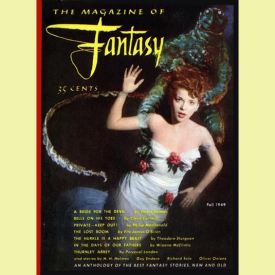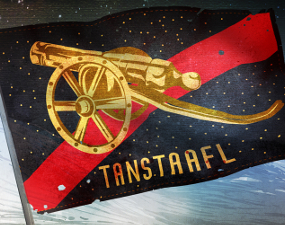
In 1949, when I was two years old—a year too young to be reading it (dare I use the dreaded “LOL”?), a new magazine came out. It was called The Magazine of Fantasy, and it was published by Lawrence E. Spivak, and edited by Anthony Boucher and J. Francis McComas. This first issue (the only one to be called “The Magazine of Fantasy” without the “& Science Fiction”) consisted of five original stories and six reprints. Of the original works, two (“The Hurkle is a Happy Beast” by Theodore Sturgeon and “Private—Keep Out!” by Philip MacDonald) have often been anthologized, and Boucher had a story as well by his pseudonym H. H. Holmes. The rest, reprints and originals, pretty much sank back into the morass of Sturgeon’s Law, I’m guessing. Figure 1 shows the cover; a rather undistingushed photographic effort by Bill Stone. Covers on later issues were often by Ed Emshwiller (EMSH) and in later years Mel Hunter’s robots were favourites of both the editor(s) and readers.
The Hurkle story was only notable, really, because it was Sturgeon, though it was memorable enough that I vaguely remember it. If I’ve read the MacDonald or any of the others, I don’t remember them… but in well over half a century of reading SF/F novels, short stories and everything in between, well… one’s memory tends to gloss over some of the less noteworthy stuff. MacDonald is memorable as a writer for the SF/F fan, mostly because under his W.J. Stuart pseudonym, he wrote the novelization for the 1956 film Forbidden Planet—which, as most of you already know, was based very loosely on Little Billy Shakespeare’s The Tempest.
Over the next sixty-six years F&SF (as we have called it for years) had a number of editors: Boucher & McComas did it for about 5 years, then Boucher went it alone for another five. Robert P. Mills took over for another five years, and Avram Davidson did it for about three years. Joseph W. Ferman took over for Avram for a couple of years—at least officially on the masthead—it’s said that his son, Edward L. Ferman, actually did the editing. Then Ed Ferman edited it from 1966 to 1991! Kristine Kathryn Rusch edited it from 1991 to 1997, only to be followed by Gordon Van Gelder, who brought C.C. Finlay on as co-editor for part of 2014; now in 2015, C.C. Finlay is sole editor, with Gordon Van Gelder as publisher. (The part of publisher was often, though not always, played also by the editor in many of the preceding years.) Although the frequency of publishing has also varied (as of now it’s bimonthly), F&SF has been a constant presence on the professional SF/F scene—and we hope it can continue for a long time! (Of course, we have to say that we are looking forward to the day when Amazing Stories will return to the newsstand where it belongs!)

Which brings us to the current issue: although dated November/December 2015, it’s out on the newsstands now, with a cover by David A. Hardy, which utilizes his little green alien that has graced a number of F&SF covers. Hardy is a Fellow and founding member of the IAAA (the International Association of Astronomical Artists), and his covers show his amazing grasp of astronomical art. (I mention the IAAA, because another founding member, Rick Sternbach—he of Star Trek The Next Generation fame as well—was our Art GOH at VCON 40 this past weekend. And a splendid time was had by all.)
On to the stories in the current issue (see Figure 2 for the David A. Hardy cover)—oh, I guess I should tell you that as a reviewer, I only see the fiction (stories and poetry); if I want to read the non-fiction I have to buy a copy. So I won’t talk about any of the non-fiction for now. Here’s the contents as I see them:
Jeffrey Ford – “The Winter Wraith”
Tim Sullivan – “Hob’s Choice”
Maria Dahvana Headley – “The Thirteen Mercies”
Sophie M. White – “Phases” (poetry)
Carter Scholz – “Gypsy”
KJ Kabza – “Her Echo”
Harvey Jacobs – “The Fabulous Follicle”
Bruce McAllister – “DreamPet”
Naomi Kritzer – “Cleanout”
Norman Birnbach – “It’s All Relative at the Space-Time Café”
Robert Reed – “The City of Your Soul”
Lisa Mason – “Tomorrow Is a Lovely Day”
I started reading in at the end, with Lisa Mason’s sparkling short, “Tomorrow is a Lovely Day,” which combines FTL messaging, time repeats (like Groundhog Day), Nostradamus, the world (as usual) falling apart and other familiar items into a well-written mélange that just might be about the end of the world as we know it. (Or maybe not….) Lisa is the Philip K. Dick-nominated author of Summer of Love (and other works) and editor of the PK Dick Storybundle—where you pay what you want for a bunch of terrific ebooks; this bundle is available for another six days only!
Then I jumped into Sophie M. White’s poem, “Phases”—which contrasts the prosaic description of phases of the moon with other cultures’ views of those same phases, quite succinctly. You may have to look up at least one of them… I did!
Jeffrey Ford’s “The Winter Wraith” is dedicated to the great—and long-time F&SF—writer Kit Reed, as she suggested the title to the author in an online conversation. (I read this one next, as Kit has long been one of my literary heroes; her F&SF story “Automatic Tiger” has stuck with me for years!) It concerns a man in an old farmhouse somewhere in Ohio, whose wife is off in Shanghai during the post-Christmas season. He’s dealing, as most of us have had to, with a dead Christmas tree, gone brown and brittle, shedding needles and ornaments with equal abandon. (This is one reason we’ve finally given up on Christmas trees… we had to skip a couple of years while the cat was young to avoid having major accidents, so finally we just said “The heck with it!”) It’s well written—I especially liked one image of the tree hitchhiking.
By the way, I heard a program on CBC the other day while I was driving—people who are unable to form those kinds of mental images are now said to have “aphantasia,” pronounced “ey-fant-uh-see’-a.” Until then, I was unaware that anyone—otherwise normal—was unable to make mental images. Those people are unable to enjoy fiction or poetry. Such a shame, that.
“There’s never been a world that isn’t a world at war.” That’s pretty much how Maria Dahvana Headley’s story, “The Thirteen Mercies” begins. It’s a look at how Mercies are the reverse coin of punishments, and how maybe all punishments are deserved. If Clive Barker had thought of the Thirteen Mercies, he might have written something similar, though her writing is nothing like his.
According to the preface, “It’s All Relative at the Space-Time Café,” is Norman Birnbach’s first published SF story. It’s kind of an extended pun (no, not a Feghoot), and reminds me of a Big Bang Theory episode on steroids. It ended just in time; any more and it would have been too long.
KJ Kabza’s “Her Echo” is a one-page fable. I liked it just fine. (That, by the way, is from the story.)
Bruce McAllister’s “DreamPets” is future fiction; but not a long way in our future, either. The narrator designs “Domestic Pleasure Animals,” or DPAs, for the company he works for, DreamPets. Like many narrators in many stories, has what we might consider a good home life, but his children are growing up, and even the littlest ones don’t remain children forever. And they want, and will want, their own lives. There are two sides to every coin; and maybe the happiest designer in the world isn’t all that happy after all.
“The Fabulous Follicle” by Harvey Jacobs is a business story. It’s about Morris Fein, a barber, who strikes out on his own. How to become a success? Find a need and fill it! (Hey, Bernard Baruch said it first.) Things get a little hairy, but it’s all smooth at the end!
Naomi Kritzer’s “Cleanout” starts with a scenario that’s very familiar to those of us who’ve lost their parents. Although the narrator’s father was dead, the mother was still alive and not expected to last long; she and her sisters were at the parents’ house to clean it out. Her parents were, she knew, escapees from the Soviet Union, many years before. Her parents were hoarders, basically—as my mom had been (my dad having died a number of years previous—and she and her sisters needed to winnow through the rooms full of junk to see what, if anything, was worth saving. A bag of native soil? No, their parents weren’t vampires, if that is what you were thinking, but something much simpler and yet much odder.
Robert Reed comes up with an explanation, maybe, for things that go missing, in “The City of Your Soul.” We’ve all had unexplainable vanishes in our lives; maybe something as simple as a sock. But there are all sorts of imaginable and unimaginable explanations for things missing. Have you read Avram Davidson’s “Or All the Seas With Oysters”? There’s an explanation for missing coathangers in that one. But what explains a missing city? Reed, a Writers of the Future grand prize winner (if I remember correctly), has a whole new explanation.
Tim Sullivan’s “Hob’s Choice” is set in the heavy-gravity world of Cet Four that he’s written about in F&SF several times before. Travel is, apparently by tachyon beam—people are “reprinted”—and the Ceteans are being overwhelmed by colonists. Their swampy world is in danger of being overrun by Earthian structures; there is, however, an underground, and Hob’s grandmother—who is one of the very few in the universe who can speak to the Ceteans—is a part of it. Hob, unknowing and unwilling, finds that he, too, can speak to them. Is he a tool of the Tachtrans Authority, or one of the rebels? And do the Ceteans have more going for them than anyone suspects? Kind of a cool and explosive story. Parts of it remind me of Jerry Sohl’s The Transcendent Man.
And the longest story or novelette in this issue is “Gypsy,” by Carter Scholz. The year is 2043, and Earth is inhabited by ten billion plus people. The human species is sliding into slow suicide, but a single starship with a magnetic solar sail leaves to attempt to save something on a supposed planet of Alpha Centauri. Rocky, but with water, it is a scientist’s dream to get one egg out of this fragile basket—and not everyone agrees that the planet exists. There are hibernation drugs—and antisenescence drugs—to keep the crew alive during the long voyage. And no way to know whether Earth itself will be there when they arrive at their destination—which may not be livable anyway. But they have to try. Well written, a “hard science” story (supposedly the provenance of Analog) told through human crewmembers. I found it definitely worth reading.
So there you go; after all these years, F&SF is still right up there with your “must-read” fiction, in my opinion. Give it a shot—if your local newsstand doesn’t carry it (and there are fewer and fewer outlets for actual magazines), then you can subscribe online here or buy it through Amazon.com.
I really am interested in your opinion of this column. If you have anything to say about it, good or bad, please post your comment here—it’s easy (and you can even sign up to get automatic notifications of new columns!). Or you could comment on Facebook; I post links every Friday when a new column comes out. My opinion is, as always, my own, and doesn’t necessarily reflect the views of Amazing Stories or its owners, editors, publishers or other bloggers. See you next week!
TAGS:











Recent Comments